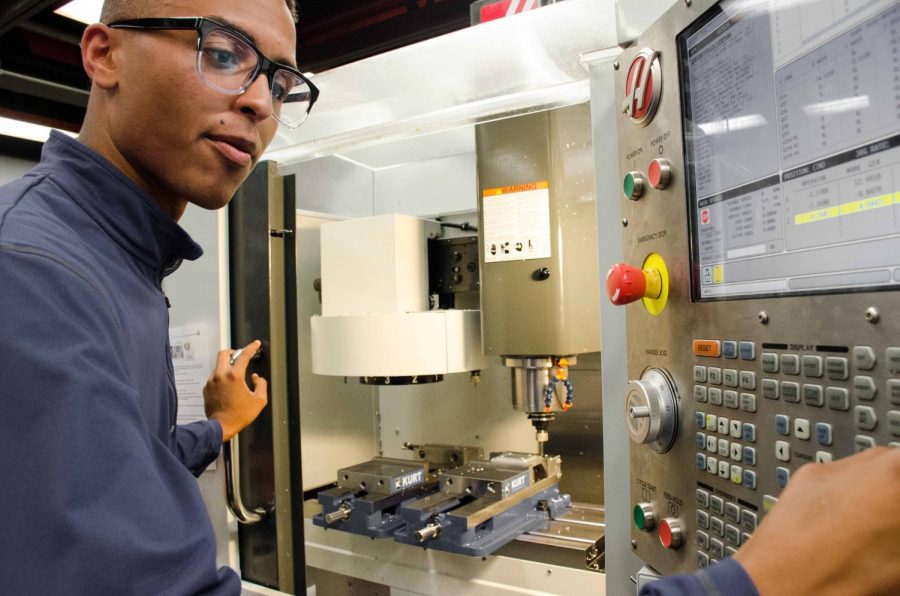Education in the face of automation
James Spencer works on an automated milling machine in the DVC machine shop on Tues, April 30th. As automated machines, like CNC ones, take over traditional manufacturing jobs, new jobs in programming and controlling them have arisen.
May 15, 2018
Diablo Valley College’s machine shop hums like a beehive, the steady whir of machines punctuated by students of the Mechanical Technology program consulting their instructors.
A sea of hammertone green, it feels old-school until you notice the little monitors hooked up to each machine.
They are CNCs, or computer numerical control devices, which digitally dictate the functions and movements of machinery and tools.
A few of the students are fabricating a batch of small metal medallions in the shape of gears to hand out at the DVC car show.
They use computer-aided design software, better known as CAD, to create a mock-up of the gear. They program the design into the CNC controlled milling machines which then cut out its precise shape from a solid block of metal, spraying delicate metallic curls against the machine’s protective plastic windows.
“Folks today are rediscovering the joys of these skills and the ability to make things for themselves,” says Steve Johnson, referring to the students.
Johnson, who is DVC’s machine shop instructor, and professor Jim Blair, who teaches business, sit across from one another at a wooden lab table littered with tools and metal scraps wedged between two of these CNC machines.
“It is disruptive. People’s lives will change,” says Blair.
The “it” he’s referring to is automation.
According to researchers at Oxford University, close to 50 percent of jobs in the U.S. could be lost to high tech machines and artificial intelligence within the next couple of decades.
While predictions vary, it is apparent that the rise of automation and machine learning will thoroughly change the landscape of the labor market as machines take over some jobs entirely, like those on assembly lines, while partially automating others, like tax accounting.
This may sound apocalyptic but Johnson points out that humans have used tools from the beginning; to him automation is no different.
“Robots replacing human beings is nothing new. Machines replaced humans a century ago in farming,” adds Blair.
Both just see it as a matter of adaptation.
But change can be hard.
“People do not always want to accept the fact that the world has changed and that they need to change with it so they don’t get left behind,” says Priscilla Leadon, DVC’s manager of workforce development.
Leadon isn’t alone in her thinking. One of the conclusions of the 2017 World Economic Forum was that education must change in order for people to stay relevant in a shifting labor market.
More recently, a March 2018 World Economic Forum article titled, “Latin America has the biggest skills gap in the world. Here’s how to bridge it,” detailed the need for an updated education curricula that combines classroom and workplace learning where both soft and technical skills are taught. The article argued this kind of combination will help workers continually adapt to changing conditions throughout their careers.
As the director of workforce and hiring at SF Made and Bay Area Urban Manufacturing Initiative, Claire Michaels already feels the disconnect between education and training and what the businesses she works with need.
A Feb. 2018 Bureau of Labor Statistics report showed nearly 6 million jobs remain unfilled due to skill gaps, both technical and soft.
Part of the problem in closing the technical skills gap may be image.
Technical education has had a rough couple of decades as its working class connotations have fallen out of favor amongst many Americans.
“Homer Simpson is a perfect example of the way we’ve viewed blue collar work in this country,” argues Blair.
Simpson, a lovable yet dribbling simpleton, spends his days bumbling through mundane tasks as a low-level safety inspector at a nuclear power plant, guzzling Duffs and shoveling doughnuts into his pie hole.
It’s a tough sell.
But Blair, Johnson and Leadon feel such perceptions are misguided.
Take the students in the Mechanical Technology program.
James Spencer, a student in the intro to CNC class, expresses that it’s fun to design and fabricate tangible objects.
And there is a real need for these skills moving forward.
Michaels explains that as manufacturing companies automate their processes, many of the traditional jobs, which were, for lack of a better term, robotic, are being replaced with new jobs in programing and controlling CNC machines.
And according to indeed.com, the average salary for a CNC programmer in the Bay Area is $72K.
With an associate degrees or certificates of achievement in these technical skills, students can choose to enter the workforce and fill these well-paying and more stimulating jobs.
Or, they can build upon this practical knowledge and go on to get a four-year degree in subjects like engineering or industrial design.
The program is creating pathways to fulfilling jobs by offering more hands on education and accelerated options for lifelong learners looking to brush up their skill sets.
As Leadon puts it, this is why “community colleges are the workhorse of the education system,” having long operated outside the box of traditional education by offering options for a diverse set of students and educational needs.
It makes sense then that the federal government has turned to them for help in educating, and re-educating, a more skilled workforce.
Johnson and Blair take this charge seriously. They envision creating public-private partnerships between DVC and local companies, like Lawrence Livermore Labs and electric car manufacturer Tesla, as a way of ensuring that education be applicable in the real world.
They also plan to foster cross-departmental collaboration allowing students to explore these necessary technical skills in combination with our more innate skills like creativity, entrepreneurship and ethical thinking.
These soft skills are equally as essential and mean humans still have a place in this world writes Joseph E. Aoun, president of Northeastern University and author of “Robot-Proof: Higher Education in the Age of Artificial Intelligence.”
Automation is sure to shake things up. Advancements in technology have always and will continue to impact society. But if Americans are willing to evolve and have access to informed education, their professions may well be more exciting and fulfilling than they were before. As professor Blair puts it, with these changes comes the, “real opportunity to make people’s lives better in the long run.”











































































